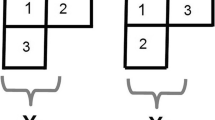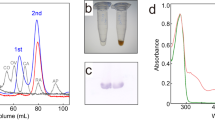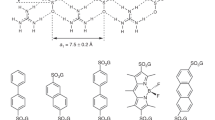Abstract
ONE of the most common heavy-atom groups now being used in the analysis of protein structures by the isomorphous replacement method is a mercuri-iodida ion derived from K2HgI4. The nature of this ion arid the mechanism of its attachment to protein molecules are, however, still unknown. It has been suggested1 that the mercuri-iodide-protein complexes may be related to the complexes formed by mercuric iodide with dialkyl thio-ethers2 and we have accordingly examined a number of these and related compounds by X-ray diffraction methods.
This is a preview of subscription content, access via your institution
Access options
Subscribe to this journal
Receive 51 print issues and online access
$199.00 per year
only $3.90 per issue
Buy this article
- Purchase on Springer Link
- Instant access to full article PDF
Prices may be subject to local taxes which are calculated during checkout
Similar content being viewed by others
References
Bluhm, M. M., Bodo, G., Dintzis, H. M., and Kendrew, J. C., Proc. Roy. Soc., A, 246, 369 (1958).
Smiles, D., J. Chem. Soc., 77, 163 (1900).
Rây, P. C., and Adhikary, N., J. Indian Chem. Soc., 7, 247 (1930).
Arndt, U. W., and Phillips, D. C., Acta Cryst., 14, 807 (1961).
Author information
Authors and Affiliations
Rights and permissions
About this article
Cite this article
FENN, R., OLDHAM, J. & PHILLIPS, D. Crystal Structure of (CH3)3S.HgI3 and the Configuration of the HgI3− Ion. Nature 198, 381–382 (1963). https://doi.org/10.1038/198381a0
Issue Date:
DOI: https://doi.org/10.1038/198381a0
This article is cited by
-
Crystal structure of the simple radical-cation salt bis(propylenedithio)tetrathiafulvalene tribromomercurate, (BPDT-TTF)HgBr3
Journal of Structural Chemistry (1991)
-
Some neutral three-coordinate complexes of mercury(II) halides and pseudohalides with N-methylnicotinamide
Proceedings / Indian Academy of Sciences (1989)
-
Mercury(II) cyanide complexes with some bidentate ligands
Proceedings / Indian Academy of Sciences (1984)
Comments
By submitting a comment you agree to abide by our Terms and Community Guidelines. If you find something abusive or that does not comply with our terms or guidelines please flag it as inappropriate.



